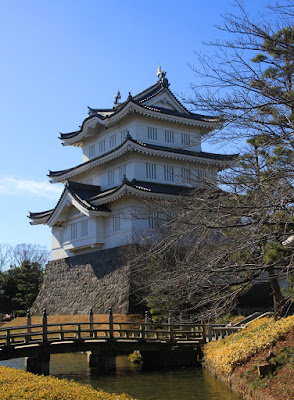 |
| (Oshi Castle) |
Kaihime (甲斐姫), daughter of Narita Ujinaga, was an effective strategist during the siege of Odawara during the Sengoku Period and her resistance at Oshi Castle against Toyotomi Hideyoshi’s 20,000 man army (led by Ishida Mitsunari in 1590). She was born in Japan in 1572, though there is uncertainty on the accuracy of this exact year. She became an superior advisor to Hideyoshi as well as his wife (due to his respect for Kaihime’s astounding military prowess and skillful contributions).
Kaihime was born during one of the most brilliant and vicious of times in Japanese history: the Sengoku Period (1467-1600). This period is also known as the “Age of Waring States,” which is unrelated to a similarly named period in China. Regardless, even though Kaihime was not part of the early years when the war and betrayal are more well known in history, such as Akechi Mistuhide’s betrayal/assassination of Oda Nobunaga at Honnō-ji, she still dealt with the brunt of a serious time of war. The most well known of her exploits took place during the aforementioned siege of Odawara and the defense of Oshi Castle.
As far as the actual battle is concerned, Mitsunari flooded Oshi Castle as his troops were stationed at a higher point. This was an attempt to force Ujinaga’s forces out of their solid defensive position. At first, it was an extremely successful maneuver. The castle’s inhabitants were forced to find higher ground; however, Kaihime performed a successful counter, completely destroying Mitsunari’s plans.
Kaihime cleverly destroyed the dikes, a type of flood prevention, around Oshi Castle to repel and devastate her enemies. She quite literally counter-flooded her flooders. It was an astounding success: Mitsunari’s forces were nearly completely wiped out. Moreover, according to some reports, Kaihime responded to the survivors by donning armor and leading 200 soldiers as a rout. Her bravery and fearlessness in battle alongside her cleverness awarded her the respect of Hideyoshi himself, only to be noted at a later date.
After a surrender was decided between Hideyoshi and Ujinaga due to a defeat of Ujinaga allies, Kaihime and her relatives were taken under the wing of Hideyoshi’s forces as a form of captive. A rebellion thought to be started by Kaihime’s uncles led to the death of Kaihime’s mother-in-law. Enraged, Kaihime effectively found the “fire-starters” and quickly ended them. This captured both the attention and awe of Hideyoshi himself, who would later unite all of Japan. He soon took Kaihime as his wife and promoted her father to the prominent position of trusted general.
Although Kaihime did garner a level of recognition in a society that was a clear patriarchy, being granted the a level of military advisement to Hideyoshi, she still didn’t receive nearly as much recognition as she deserved. Sadly, despite the fact that she was the one to completely rout an army of 20,000 with a flood and little more or less than 200 soldiers and counter a revolt with swift and decisive action entirely on her own, it was her father who became Hideyoshi’s trusted general. Of course, one must consider the society at the time. It featured the parent gaining either honor or dishonor based off of both their own actions as well as the actions of their children. Even so, Kaihime was an intelligent and skilled woman warrior that deserves praise for her epic feats.
As a final fact, Kaihime did gain enough fame to be featured in games such as Samurai Warriors 3, Samurai Warriors 4, and Takeda 3, despite not having all that much clarity on the specifics of her life in general. She has had other appearances as well, but this shows that Japan recognizes and admires her historical significance, even if it’s translated through pop-culture. It would be a wonderful thing for more women warriors to garner more and more recognition for their various actions, just as Kaihime (to varying extents) gains herself.
Works Cited
Akasegawa, Jun, et al., Himegimitachi no Dai Sengoku Emaki. Tokyo, 2009.
Japan Registry Services. Umoretakojo. Japan Registry Services. http://umoretakojo.jp/Shiro/Kantou/Saitama/Oshi/. Accessed 21 Oct. 2019.
Konuma, Yasumichi, and Ōsawa Shunkichi. Narita-Ki. Rekishi Toshosha, 1980.
Featured Images
Kalpana, Kalpana. “Kaihime - Alchetron, The Free Social Encyclopedia.” https://alchetron.com/Kaihime. Accessed 23 Oct. 2019.
Mark Williams Media. “Japan - Oshi Castle and Shrine.” http://www.markwilliamsmedia.com/japan—oshi-castle-and-shrine.html. Accessed 23 Oct. 2019.





Kaihime sounded like a truly brilliant soldier! The fact that she was a strategist would go against the notion of women only being hysterical and emotional, which inhibits them from thinking logical at times when needed! Her bravery and intellect is the reason for the amount of success in the battles! Quite frankly, if it wasn't for her, many of those battles would not have gone so smoothly and successfully! Also, I remember playing Samurai Warriors and not realizing of her importance in the history of Japan! Awesome blog Zach!
ReplyDelete